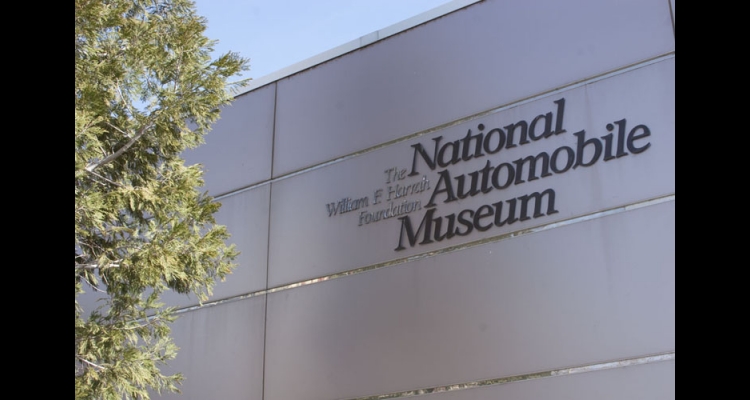National Automobile Museum
The National Automobile Museum evolved out of casino magnate William F. Harrah's well-known auto collection, and opened in 1989 in its current facility on the banks of the Truckee River in downtown Reno. The museum has been ranked one of the top ten automobile museums in the country by Car Collector magazine and by the editor in chief of Road & Track magazine, and as one of the top sixteen internationally by AutoWeek magazine.
Bill Harrah, founder of Harrah's casinos and hotels, was an avid and knowledgeable collector of automobiles, and had created a display space for them in a large warehouse in Sparks, with many hundreds more in storage. Harrah died in 1978 and the automobile collection, along with the Harrah's Hotels and Casinos, were purchased by Holiday Corporation in 1980. Holiday Corporation auctioned off most of the collection. However, a public outcry to keep some of the autos in Reno resulted in the donation of 175 vehicles to the newly formed National Automobile Museum, a nonprofit organization, to form the core of the new museum. Support for acquiring the land and building the museum came from many sources, including a state legislative appropriation and the City of Reno Redevelopment Agency.
The museum's collection now contains over 200 vehicles, including such unique cars as the 1907 Thomas Flyer, which won the 1908 New York to Paris automobile race; a 1913 Stutz Bearcat race car; a 1925 Duesenberg roadster; a 24K gold-plated DeLorean; the Dymaxion car, the only surviving one of three concept car prototypes designed by Buckminster Fuller; a 1953 Corvette that belonged to John Wayne; and several other celebrity cars. The dates of the cars in the collection range from 1892 to the 1980s. Many of the cars still run, and the museum is often invited to participate in parades and other public events outside the building. Their special autos are also invited to show around the country at concours d'elegance—displays and competitions for unique and beautiful cars.
The collection is arranged in the 105,000-square-foot facility in four main galleries, plus street scenes placing autos with other artifacts of their era. The first gallery features cars from the beginnings of the automobile era through 1910, the second from the teens through the 1930s, the third gallery covers the 1930s through the 1950s, and the fourth permanent gallery goes from the 1950s on and looks at the enormous growth of the automobile industry and the corresponding development of suburbs and modern American transportation systems. The final gallery also includes the museum's collection of race cars and a changing gallery of "masterpieces" from the collection. The museum also produces changing exhibits each year, focusing on particular automobiles, special cars in their collection, or themes relating the auto to other aspects of American culture. In addition, the museum includes an orientation theater, a store, and an extensive research library.
The central mission of the museum is education, using the history of the automobile as a central theme in understanding American history, culture, technology, and arts. Cars are seen as primary sources for study, learning, and entertainment. The museum continues to collect automobiles and related artifacts. In addition to their changing exhibits, they produce many special programs such as lectures, workshops, and films, and they host many school tours, providing lesson plans for teachers that relate automobiles to various subjects. The museum is especially popular with out-of-town tourists, but the many special events also attract local residents.
The museum is active in the National Association of Automobile Museums and has received many NAAMY awards, bestowed by the Association, for their publications, education programs, exhibits, and promotions. The Museum's quarterly publication Precious Metal has received other awards, including several Golden Quill awards from Old Cars Weekly News & Marketplace. Precious Metal features articles about cars in the collection, automobile history, upcoming special exhibits and events, practical articles for car collectors and owners, and updates on changes at the museum. The museum also published its first book in 2007, titled Against All Odds, a history of the 1908 New York to Paris automobile race and the car (which the museum owns) and driver that won. They are working toward accreditation from the American Association of Museums, which is a nationally recognized seal of approval that a museum has high professional standards, a commitment to excellence, accountability, and a focus on continued improvement.
The National Automobile Museum has a board of twelve trustees, along with an advisory board and several honorary trustees from the Harrah family. It is supported through admissions, gift shop sales, space rental for special events, individual donations, and foundations. The mission of the National Automobile Museum (The Harrah Collection) is "to collect and preserve the automobile for future generations with an emphasis on vehicles collected by William 'Bill' Fisk Harrah, to tell the story of the impact of the automobile on American society, and to perpetuate the legacy of Mr. Harrah as a renowned collector. The Museum fulfills this mission thorough a variety of methods incorporating arts, cultural and educational programming, events, exhibits and the interpretation of its collection."
Article Locations
Related Articles
None at this time.


